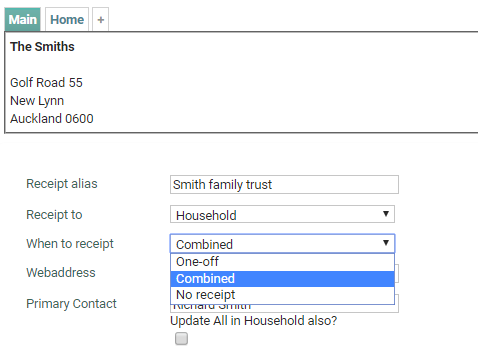infoodle uses a number of terms to facilitate its workings. The intention is to use commonly used terms, but also try and make them generic to different type of organisations. Below is a table of the key terms.
| Receipt to: Individual | When generating a receipt, and the transaction is identified as one to receipt to an individual, then the persons first and last names are used. These may be combined (e.g. Mr A & Mrs J Smith) if they share a giving number. |
| Receipt to: Household | When generating a receipt,, and the transaction is identified as one to receipt to a household (or organisation) then the household name will be used instead of the persons name. This is used most often when it is for a business. |
| Receipt to Alias | This field - which can be changed on the persons screen in the household section, is used instead of the household (or organisations) name when generating a receipt that needs to be receipted to the household. Basically you are able to provide an alternative name to use for the organisation. This is useful when you use the household name e.g. The Smiths, for letters and regular emails, however they are giving their donations on behalf of the "Smiths Trust". By setting this field, you are telling infoodle which name to use in the receipts area. |
| Giving numbers | These a numbers that can be used to search for people instead of their names. In addition they provide the mechanism whereby you can combine 2 peoples donations into one receipt. In order to work successfully you need the following: a) Each person to be in the same household. b) Each person to have the same giving number. |
infoodle Definitions & Terminology for Different Countries
Different countries use different terms which can cause confusion. Here are a few definitions that hopefully will make things a bit clearer.
Household
Households/Organisations help sort people into collections based on their living arrangements or affiliations. Infoodle uses the term household to either describe multiple people that live at the same address e.g. family members or multiple people that work at the same address e.g. colleagues working for the same organisation. It is important to note that Households/Organisations are not the same as Groups.
Receipts & Statements
In infoodle terms our definition of a Receipt (also referred to as Contribution Statements in some countries) is a tax document with a unique number given on receiving a payment/donation. Depending on the preferences of the person paying this receipt can be either
- a One-off receipt or,
- a Combined receipt.
A One-off tax receipt is a receipt with one transaction on versus a Combined receipt which combines all the transactions in a given time period on one receipt. In infoodle it doesn't matter when you choose to do the receipting, ie you could do them daily, weekly, annually, etc but what determines whether there is one transaction per receipt or multiple transactions on one receipt is the When to receipt field in a contact person's profile. (see screenshot below).

So when one person makes a donation/payment the transaction(s) are waiting in the Receipt screen to be receipted. Depending on whether the person has their default as One-off or Combined determines whether there will be one or multiple transactions on the receipt. Once a receipt has been generated a unique number is allocated to the receipt and shouldn't be generated again, however if you have already generated a receipt for someone and they lose it so need another copy you can resend or reprint it for them by clicking on Printed Receipts
See Searching for a Printed Receipt for more information
The reason a receipt generates a unique number is for tax purposes. If you want to generate multiple documents for one transaction ie send a summary statement twice a year for the same and additional transactions, then it is better to use a Statement versus a Receipt.
A Statement allows you to print off a summary of transactions/activity for a chosen period but does not generate a unique number as a receipt does and does not mark the transaction as receipted. So what we usually recommend is during the year generate statements for people and then at the end of the year generate a receipt which will then have a unique number on it and can be sent to the Tax department.
See Definitions for additional Definition information